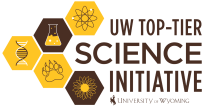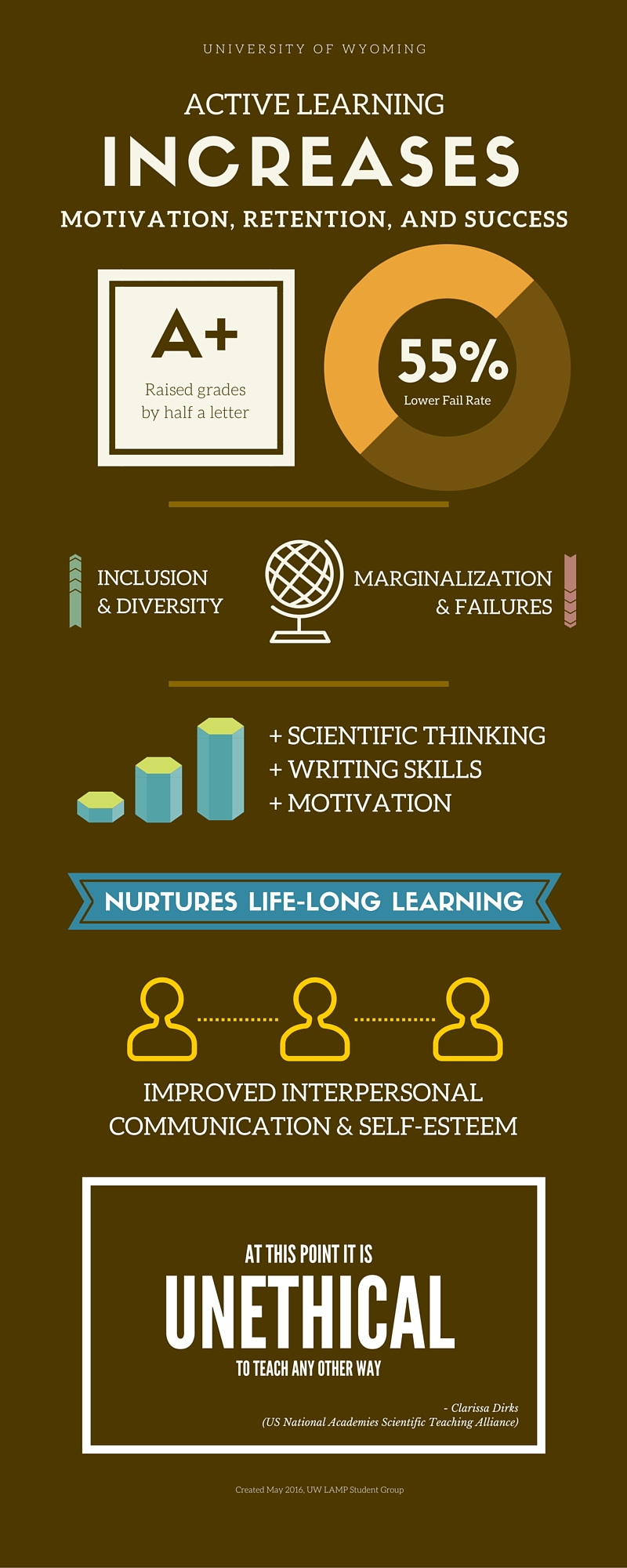Contact Us
UW Science Initiative
SIB Rm 2030
Department 4325, 1000 E. University
Laramie, WY 82071
Phone: 307-766-4415
Email: SI@uwyo.edu

Active Learning Outcomes
Providing spaces and training to facilitate large-scale, quality active learning in STEM gateway courses at the University of Wyoming is essential. In July of 2015, Nature published the article entitled The Science of Teaching Science. Perhaps one of the strongest statements made in that article was the quote of Clarissa Dirks (co-chair of the US National Academies Scientific Teaching Alliance), “At this point it is unethical to teach any other way.”

Decreased failure rates
Failure rates that are 55% lower; Students in a traditional lecture class are 1.5
times more likely to fail (Freeman, 2014). DFW rate may be 1/4th of that seen in traditional
courses (Kramer, Brewe and O’Brien, 2008).
Increased academic success, understanding and retention
Improved academic achievement (Johnson, Johnson and Smith, 1998; Springer et al.),
raised academic grades by half a letter (Freeman, 2014); Increased retention of material
(Handelsman et al., 2004; McKeachie, 1972) and better conceptual understanding (Beichner
et al., 2007; PCAST, 2012).
Increased Inclusion and Diversity
Increased inclusion and success of marginalized students: AL Appears to close gender
gaps (Streitmatter, 1994) and achievement gaps (Haak et al., 2011). The decreased
failure rate in active learning classrooms is even greater for African American and
Native American minority students than it is for majority students (Beichner, 2007).
Increased Global Citizenry
Improved perception of greater social impact (Johnson, Johnson and Smith; students
see the social and environmental change made possible by their work (Simon et al.,
2013).
Increased engagement
Increased engagement (Allen et al. 2011; Freeman et al., 2014) and improved learning
gains due to this engagement (Redish et al. and Laws et al).
Increased motivation to learn
Increased student motivation and level of interest (Ahlfeldt et al., 2005; Butler,
2001; Gonyea et al. 2010; Light, 2001; Murray & Summerlee, 2007). Increases positive
learning attitudes of both low and high GPA students (Park and Choi, 2014).
Increased science professional skill
Improves student ability to think like scientist, helping "students develop the habits
of mind that drive science,” (Handelsman et al., 2004). Positive impact on students’
writing skills (Bonwell and Eison, 1991). Improved lab measurement skills (Beichner
et al., 2007).
Increased likelihood to learn throughout a lifetime
Nurturing of life-long learning (Smith et al., 2005).
Increased interaction and esteem
Improved quality of interpersonal interaction and improved self-esteem (Johnson, Johnson
and Smith, 1998).
Increased long-term achievement
Early college learner-centered & inquiry-based courses, focusing on critical thinking,
collaboration and inquiry, increase long-term student achievement (Derting and Ebert-May,
2010).
Cited References
Contact Us
UW Science Initiative
SIB Rm 2030
Department 4325, 1000 E. University
Laramie, WY 82071
Phone: 307-766-4415
Email: SI@uwyo.edu

